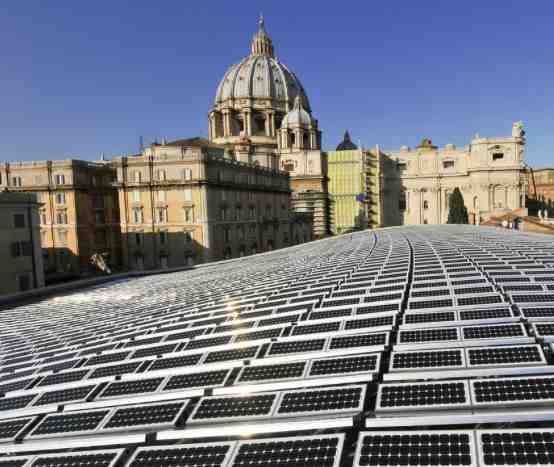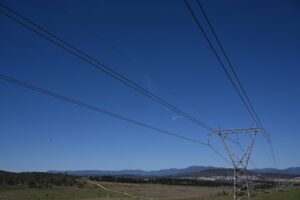 Six years ago, Pope Benedict XVI installed more than 1,000 solar panels on the Vatican’s audience hall, helping him earn him the sobriquet of the “Green Pope”.
Six years ago, Pope Benedict XVI installed more than 1,000 solar panels on the Vatican’s audience hall, helping him earn him the sobriquet of the “Green Pope”.
Some time in the next few months, his successor Pope Francis may just go one step further. His actions could tip the balance against fossil fuels, as the world’s wealthiest institution takes on the world’s most powerful industry.
The signs have been building. In November, the Pope sent a letter to Australian Prime Minister Tony Abbott urging him to address climate change and sustainability at the G20 summit – something Abbott had pointedly refused to do.
At Lima, the Pope sent another letter urging diplomats to agree on a strong deal to tackle climate change as UN negotiations drew to a close. In a message to Peru’s environment minister, Manuel Pulgar Vidal, who led the discussions in Lima, Francis warned that “the time to find global solutions is running out.”
A group of Catholic Bishops went one step further, calling for an end to fossil fuel use, citing climate change’s threat to the global poor as the lodestar of their concern. The document, signed by bishops from all continents, insisted on limiting global temperature rise to 1.5°C relative to pre-industrial levels — a considerably more ambitious goal than the 2°C ceiling that’s generally agreed on as the threshold beyond which climate change becomes truly dangerous.
They also called for the building of “new models of development and lifestyles that are both climate compatible” and can “bring people out of poverty.” Specifically, they said: “Central to this is to put an end to the fossil fuel era, phasing out fossil fuel emissions and phasing in 100 per cent renewables with sustainable energy access for all.”
There is growing speculation within church circles that this view is held at the highest level. Pope Francis wants the image of the Catholic Church to evolve beyond that of a huge multi-national corporation, to its origins as a social and humanitarian based organisation.
As he showed in his extraordinary speech this week to the priests, Pope Francis is very much his own man, not of the establishment. Francis told the bishops and cardinals who run the Curia – the central administration of the Roman Catholic Church – that their careerism, scheming and greed had infected them with “spiritual Alzheimer’s”.
It was Benedict, though, who put the wheels in motion. The solar panels on the audience hall were enough to power the lighting, heating and cooling of a portion of the entire Vatican state. According to this National Geographic article, he authorised the Vatican’s bank to purchase carbon credits by funding a Hungarian forest, thus making the Catholic city the only fully carbon neutral nation-state.
Several years later, he unveiled a new hybrid Popemobile that would be partially electric. Francis went a step further, commissioning Osram to install 7,000 LED lights in the Sistine Chapel, cutting energy consumption by 90 per cent. It is now being extended to other Vatican museums.
But how much further could Pope Francis go? There is speculation that in his Encyclical, due in April, or even in a New Year’s speech, he could call for dramatic reform by the Catholic church. It would be similar, but bolder and more practical, than the Ecological Conversion address of Pope John Paul II in 2001.
This could include divestment. No one knows how much the Catholic Church has in its funds. It is likely to be hundreds of billions. The Uniting Church in Australia has voted to divest from fossil fuels. In July, the World Council of Churches, an umbrella group representing over half a billion Christians, announced its plans to fully divest from fossil fuels.
The SMH reports that in the same month, the Anglican Church of Australia passed a motion encouraging its diocese to divest. It noted then than a global campaign for the Vatican to divest had just been launched. Ironically, the Vatican’s finances are now controlled by Cardinal George Pell, the former archbishop of Sydney who is a noted climate science denier.
 There is speculation that the Pope could emulate the bishops’ call for 100 per cent renewables. What he could do is repeat and enhance the efforts to install solar and lighting at the Vatican across the church’s global assets. In effect, he could follow in the footsteps of other corporate giants – such as Google, Apple and Ikea – and set a goal of 100 per cent renewables for his own church, or corporate entity.
There is speculation that the Pope could emulate the bishops’ call for 100 per cent renewables. What he could do is repeat and enhance the efforts to install solar and lighting at the Vatican across the church’s global assets. In effect, he could follow in the footsteps of other corporate giants – such as Google, Apple and Ikea – and set a goal of 100 per cent renewables for his own church, or corporate entity.
The Catholic Church is not just the largest private employer in Australia (and other countries), with some 180,000 employees, it is also one of the biggest energy consumers – with a combined annual bill that runs into the billions of dollars from schools, aged care centres, churches, parish centres and hospitals.
A series of initiatives that encouraged energy efficiency, the installation of solar systems – schools would be perfect for this because usage matches solar output – and also battery storage would have a profound impact on the incumbent energy system, hastening the inevitable transition to decentralised energy grid.
Not only will this encourage and facilitate a much higher overall adoption of renewables, it will also likely result in cheaper energy for all consumers. Major network providers in Australia see this as inevitable, and are already installing – without subsidies – battery storage instead of upgrading grids, and talking of renewables-based micro-grids instead of relying on the old centralised model.
In the US, the combined energy consumption of Catholic organisations – schools, hospitals, aged care, churches, seminaries and the like, would run into the tens of billions. In Europe, the same again.
But if the Pope’s criticism of the Curia was greeted by stunned silence in the Vatican, it is unlikely that any move towards divestment or a massive uptake of renewables would be greeted in the same way.
The fossil fuel industry is certainly worried. Rio Tinto CEO Sam Walsh, who has repeatedly told everyone that the future is coal, took part in a “day of reflection” at the Vatican in September last year. It was ostensibly billed as a chance for mining companies to get “Christian ethical input” to their conversations about the future of their industry. Others saw it as a lobbying exercise.
More recently, the AFR reports, Walsh and other CEOs of major fossil fuel companies took part in an “Ecumenical Day of Reflection on Mining” at Lambeth Palace, the seat of the Church of England, another massive institution – both in terms of funds, and energy consumption.








